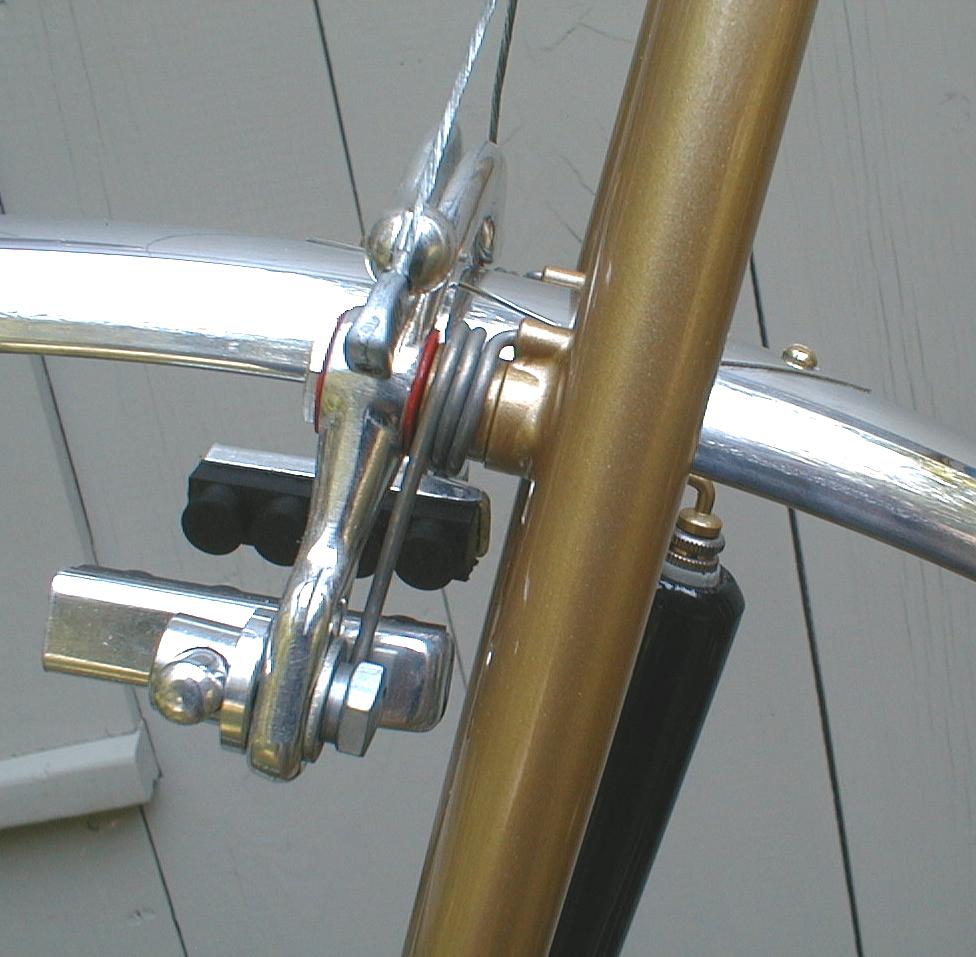I've been noticing lately, however, that quite by accident, the Biographically-Themed Greg Curnoe Bike is also very Autbiographical. For example, the paint scheme—the highlight of the bike—is going to have horizontal panels on each tube, with yellow on top and green underneath. This is primarily to match the Curnoe painting upon which the bike is based, but also incorporates the paint schemes of the two bikes it's going to replace, pictured at right.
The green Marinoni was my first ever road bike. In the summer between first and second year of university, I remember seeing someone riding on a lugged steel road bike, and being extremely drawn to the thin tubes. This was at a time (around 2001) when road bikes were still very uncool (at least in London, Ontario) and somewhat unusual. I myself had been riding an ugly CCM road bike all through high school. It was my aesthetic reaction to that bike that made me decide to get a road bike. I looked on eBay (one of my first eBay purchases) and found my green 1991 Marinoni Special from a seller from Sudbury (where I was born—another autobiographical element!) for $300. I had no idea what I was buying, but the gods were clearly watching this purchase closely. It's a gorgeous bike—the more I work on my own frames, the more I realize this. And it's been my main bike since then—I even did a two-week-long tour on it once!
The yellow Brigantia was my first handmade bike. It was built by an amateur in Toronto (much as I, an amateur, will build its replacement in Toronto) and while it amateurishness shows in some respects, I've gotten a lot of ideas from it.
In addition to the colours, Greg Curnoe Bike will also incorporate many of these bikes' most distinctive features: double-tapered stays and a low bottom bracket from the Marinoni, generous tire clearance and long point lugs from the Brigantia. I'm also pillaging parts from both bikes: the stem, bars, and headset are coming from the Marinoni, along with the cassette. Briggs is donating the Chorus derailleur. (I'm going to keep these frames as "scultpures," I think.)
While I'm obsessively analysing every aspect of the Greg Curnoe bike, let me also note that I got myself a copy of The Competition Bicycle by Jan Heine for Christmas, and noticed a lot of similarities between GC Bike and the Cupertino Bike Shop's Cinelli Supercorsas. They not only share lugs (Cinelli CSes) and fastback seatstay attachments, but both use Mafac brakes. I'm always looking for ways to "justify" my departures from the bike in the Curnoe painting. Mostly I think that just as Curnoe needed to adapt the actual Mariposa to his aesthetic needs, I need to adapt his print to my athletic needs. But the famous Cupertino Cinellis help to explain two of my most obvious departures from the print—the brakes and the lugs—through their connection to the fastback. Supercorsas undoubtedly have the most famous fastbacks of any production bike—and the fastback is the most distinctive feature of the Mariposa in the Curnoe print. (The Competition Bicycle is a really nice book, by the way! Get the last of the first editions while you can!)
I've been up to a few things over the Christmas break. The first is building up a set of clincher wheels for the GC. Practicality suggests that I will ride this bike more often, and over longer distances, if I don't always have to worry about puncturing my expensive Dugast tubulars. I had a pair of very nice NOS 32-hole Shimano Sante hubs in my closet just waiting for an assignment. I also had a spare Mavic MA 32H rim for the front, and some 302mm DB spokes (I still need an MA or MA2 rear rim with the appropriate decal). The resulting wheel is not only very strong and attractive, but also fits in very well to the bike's colour scheme—both in terms of the label and the massive green dust shields on the Sante hubs.
I also cleaned off the 7-speed Uniglide cassette that I was using on my Marinoni. I got this as part of a complete Santé group I bought on eBay a couple of years ago, but until I cleaned it, I had no idea it was so beautifully shiny. I'm not sure I've ever seen such nice Uniglide cogs before...
I decided to use it as a 6-speed rather than use all 7 cogs. As a 7-speed it's a 13-14-15-17-19-21-24. That 14 isn't incredibly useful; and as a 6-speed it's slightly lighter and nicer for friction shifting. (Luckily I have a rather robust collection of 6- and 7-speed Uniglide spacers...) Here it is installed on the fancy tubular rear wheel:
One of the many nice things about Uniglide is that when the cogs get worn down, you can simply flip them over, since they don't have the unidirectional tooth profiles of Hyperglide cassettes. The cogs were actually not particularly worn, but I decided to flip them over anyway. And just like that, I have an essentially brand new, shiny 6-speed 13-24 cassette...
I may finish the Greg Curnoe bike completely this week. There's just some lug filing to do, and adding three braze-ons. But there's no rush. One of the things I'm most excited about doing next is matching the colour of the paint to the actual Curnoe print. I know someone who happens to have an original, and Noah Rosen of Velocolour has agreed to go and visit it with me to match the colours of the print to those in his paint sample book. But the person with the print is out of town for another month. This will, in any case, force me not to rush the final filing...


















































